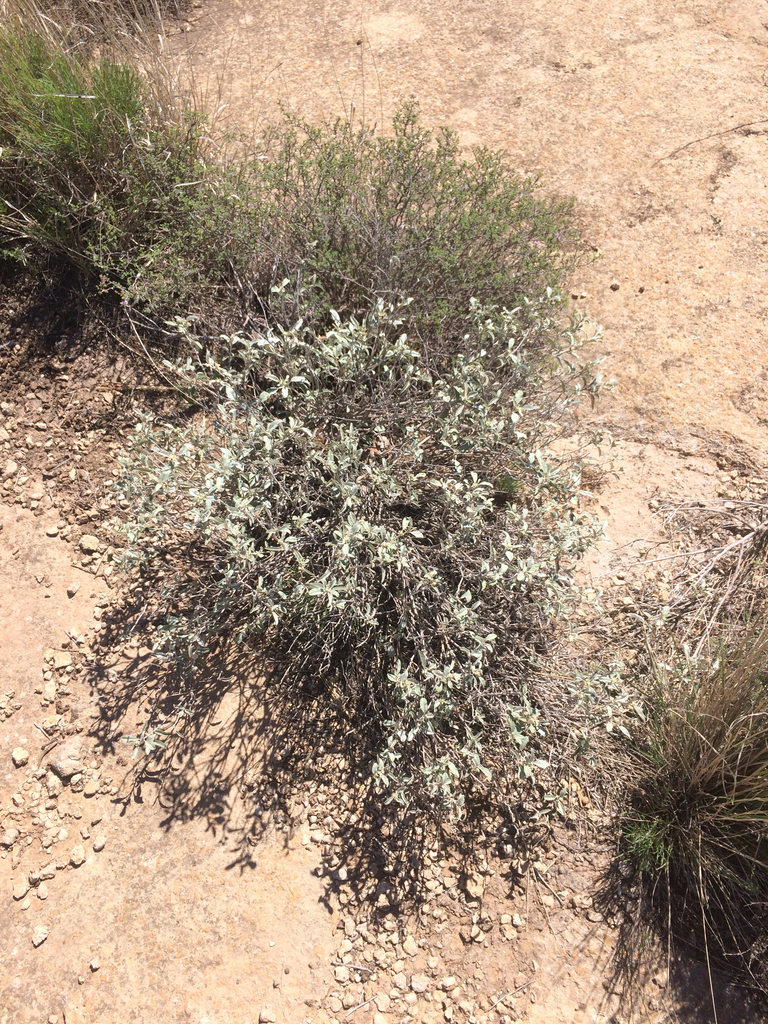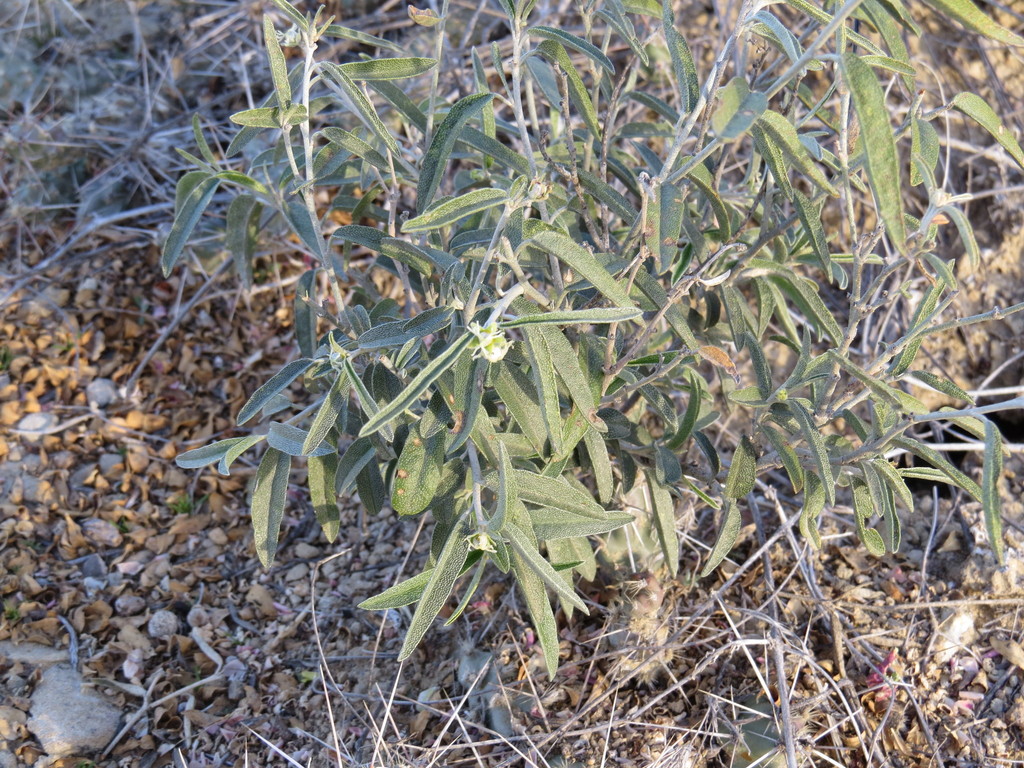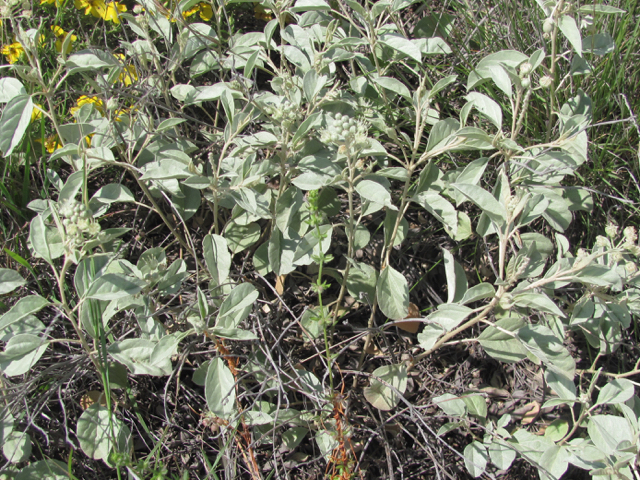Crotons of the Trans-Pecos
Unless otherwise stated, plants lack silvery scale-like hairs, have entire leaves, and have five sepals. Click on the species names to go to the species page.
1. Shrubs
See also Croton bigbendensis and C. pottsii var. thermophilus.
Croton fruticulosus: Leaves ovate and a somewhat bright green on upper surface, minutely serrated marginally.


Photo credit Chuck Sexton: https://www.inaturalist.org/observations/3646945
Photo credit Nathan Taylor: https://www.inaturalist.org/observations/6076384
Croton incanus: Leaves oblong; plants growing along and near the Rio Grande, SE Brewster Co. and east.

Photo credit Justin Quintanilla: https://www.inaturalist.org/observations/5556460
Croton suaveolens: Leaves ovate, broadly elliptical, or obovate, greyish green on upper surface; plants monoecious growing in the Davis Mountains.


Photo credit Cullen Hanks: https://www.inaturalist.org/observations/3364616
Croton sancti-lazari: Leaves ovate to elliptic-ovate, plants dioecious and growing in desert mountains and canyons.

Photo credit University of Texas Herbarium (TEX-LL): https://prc-symbiota.tacc.utexas.edu/collections/individual/index.php?occid=1401721
2. Herbaceous perennials
Croton dioicus: Plants with silvery scale-like hairs, typically compact, subshrubby; leaves typically broader than linear-lanceolate.



Photo credit Nathan Taylor: https://www.inaturalist.org/observations/5524764 and https://www.inaturalist.org/observations/9613202
Croton bigbendensis: Plants with silvery scale-like hairs, typically bushy; leaves averaging longer than C. dioicus and often becoming narrowly oblong to even linear-lanceolate.

Photo credit Kenneth Bader: https://www.inaturalist.org/observations/1140068
Croton pottsii: Plants without silvery scale-like hairs
Croton pottsii var. pottsii: Stems not much branched, straight, and erect, completely herbaceous; leaves usually acute; common and widespread.


Photo credit Chuck Sexton: https://www.inaturalist.org/observations/1534378
Photo credit Ellen Hildebrandt: https://www.inaturalist.org/observations/6267607
Croton pottsii var. thermophilus: Stems much branched, zig-zaging, and spreading with age, aboveground stems often persistant; leaves typically blunt and smaller than var. pottsii; plants restricted to hot desert locations in calcareous soil or rock in south Trans-Pecos Texas.


Photo credit Sam Kieschnick: https://www.inaturalist.org/observations/4139576
3. Herbaceous annuals
Croton glandulosus: Leaves serrated.


Photo credit Nathan Taylor: https://www.inaturalist.org/observations/7466075
Croton monanthogynus: Number style branches 4.


Photo credit Sam Kieschnick: https://www.inaturalist.org/observations/8269457
Photo credit Nathan Taylor: https://www.inaturalist.org/observations/4427442
Croton lindheimerianus: Number of style branches 6.

Photo credit Richard Reynolds: https://www.inaturalist.org/observations/515698
Croton texensis: Plants with silvery scale-like hairs, primarily found in sand dunes.


Photo credit Sam Kieschnick: https://www.inaturalist.org/observations/4252617
Photo credit Sam Kieschnick: https://www.inaturalist.org/observations/9279063
Croton lindheimeri: Sepals 6, all incurved, only one record probably introduced with a bale of hay.
No photo
Reference: Powell, A.M. and R.D. Worthington. in press. Flowering Plants of the Trans-Pecos and Adjacent Areas.




Comentarios
Wonderful guide. Thank you.
I suppose I should just go ahead and learn the South and East Texas species and put it all together in a nice guide to Texas. Though, I probably ought to put together a Texas guide to Chamesyce first. If I don't, people might start thinking I'm a Croton expert! ;-)
I think people already think that you are a Croton expert! Thanks for sharing this wonderful resource.
Excellent, excellent, excellent — bookmarked!
Also, tagging these folks to make sure that they see it too:
@gcwarbler @connlindajo @ellen5
Thanks @sambiology.
@nathantaylor7583 You ARE the expert! Looking forward to those guides you eventually publish about all things Euphorbiaceae in Texas...
(Was wondering where C. lindheimerii was, until I got to the end....
:-/ Globalization.
I rely on Nathan for most EVERYthing
I guess I ought to add iNat photos to these more often! Between Facebook and here, I've gotten a lot more positive responses/likes than I have on the others. Thanks guys!
Very helpful thank you!
Agregar un comentario